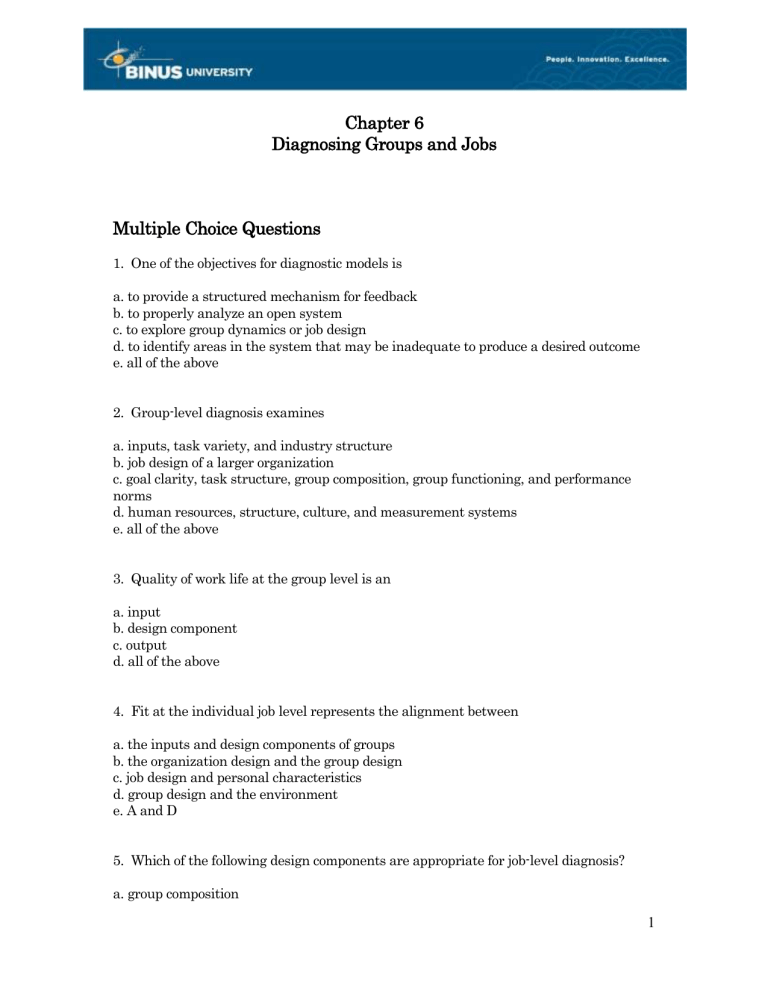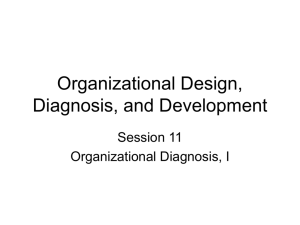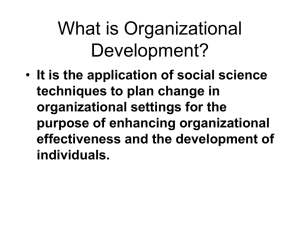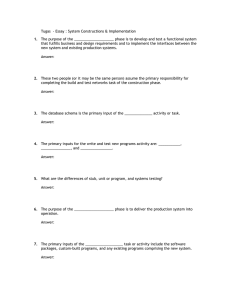Chapter 6 Diagnosing Groups and Jobs Multiple Choice Questions

Chapter 6
Diagnosing Groups and Jobs
Multiple Choice Questions
1. One of the objectives for diagnostic models is a. to provide a structured mechanism for feedback b. to properly analyze an open system c. to explore group dynamics or job design d. to identify areas in the system that may be inadequate to produce a desired outcome e. all of the above
2. Group-level diagnosis examines a. inputs, task variety, and industry structure b. job design of a larger organization c. goal clarity, task structure, group composition, group functioning, and performance norms d. human resources, structure, culture, and measurement systems e. all of the above
3. Quality of work life at the group level is an a. input b. design component c. output d. all of the above
4. Fit at the individual job level represents the alignment between a. the inputs and design components of groups b. the organization design and the group design c. job design and personal characteristics d. group design and the environment e. A and D
5. Which of the following design components are appropriate for job-level diagnosis? a. group composition
1
b. norms c. skill variety d. strategy e. A and C
6. Group effectiveness is a. an output at the group level b. a design component at the job level c. is an output at any level in the open systems model d. none of the above
7. Analysis of inputs at the group level includes a. evaluating personal characteristics of job holders b. examining the job design c. looking at design components d. determining what larger organization the group is embedded in e. none of the above
8. An output at the job level is a. task identification and autonomy b. evaluation of the organization and group designs c. job satisfaction d. none of the above e. all of the above
9. The major inputs at group level diagnosis consists of a. organization design b. task structure c. performance norms d. none of the above
True/False Questions
10. To diagnose a group, the OD practitioner carefully examines the environment of the organization.
2
11. Job design should be congruent with the larger organization.
12. Work groups are prevalent in all sizes and types of organizations.
13. An individual job is constructed to perform functions that will indirectly impact group functioning.
14. Quality of work life is a result of team effectiveness.
15. Human resources at the organization-level is a design component, but an input at the group and job levels.
16. Goal clarity is a job design component.
17. Group effectiveness has two components: quality of work life and performance.
18. Group functioning involves task-related activities such as giving and seeking information and group-maintenance functions.
Essay Questions
19. Discuss the similarities and differences among the organization, group, and job levels in open systems theory.
20. Discuss team effectiveness as an output at the group level.
21. What are the key components of group level diagnosis? Discuss how the absence of any one of these components can impact outputs.
22. Compare and contrast the “fits” for group and job level inputs and job design dimensions.
3








